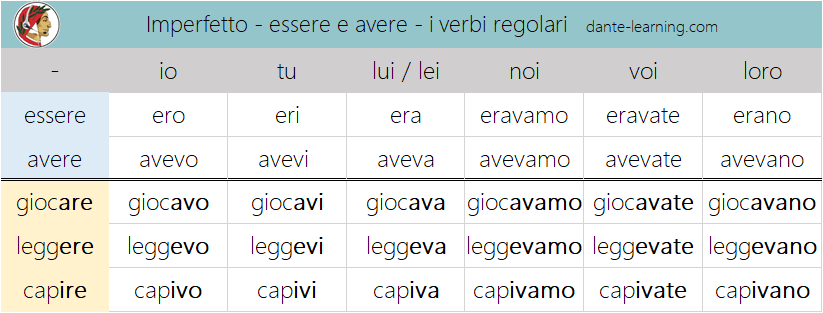Imperfetto, imperfect by name and definition, is an Italian past tense of the Indicativo
L’imperfetto, imperfetto di nome e di definizione, è un tempo passato dell’indicativo italiano. L’imperfetto è “imperfetto” perché descrive azioni passate senza un chiaro inizio o fine.
Imperfetto, imperfect by name and definition, is an Italian past tense of the Indicativo. The imperfetto is “imperfect”, because it describes past actions with no clear beginning or end.
Formazione dell’Imperfetto
Vediamo come l’imperfetto italiano cambia con i verbi ARE, ERE o IRE. La costruzione di questo tempo verbale segue schemi molto prevedibili e sistematici.
Let’s see how the Italian imperfetto changes with ARE ERE or IRE verbs. The construction of this verb tense follows very predictable and systematic patterns.
| ARE | ERE | IRE | |
|---|---|---|---|
| io | mangiavo | leggevo | capivo |
| tu | mangiavi | leggevi | capivi |
| lui/lei | mangiava | leggeva | capiva |
| noi | mangiavamo | leggevamo | capivamo |
| voi | mangiavate | leggevate | capivate |
| loro | mangiavano | leggevano | capivano |
La meccanica di formazione è semplice: si elimina la terminazione infinita (-are, -ere, -ire) e si sostituisce con le nuove desinenze specifiche per l’imperfetto. Ogni coniugazione ha le sue caratteristiche distintive: -av- per la prima, -ev- per la seconda, -iv- per la terza.
The formation mechanism is simple: you remove the infinite ending (-are, -ere, -ire) and replace it with new specific endings for the imperfetto. Each conjugation has its distinctive characteristics: -av- for the first, -ev- for the second, -iv- for the third.
I Verbi Ausiliari ESSERE e AVERE
Questo è l’imperfetto di ESSERE e AVERE. Sarà utile quando studierete il Trapassato Prossimo. Questi due pilastri della grammatica italiana mostrano comportamenti differenti nell’imperfetto.
This is the imperfetto of ESSERE and AVERE. It will come in handy when you will study the Trapassato Prossimo. These two pillars of Italian grammar show different behaviors in the imperfetto.
| ESSERE | AVERE | |
|---|---|---|
| io | ero | avevo |
| tu | eri | avevi |
| lui/lei | era | aveva |
| noi | eravamo | avevamo |
| voi | eravate | avevate |
| loro | erano | avevano |
AVERE segue perfettamente il modello della seconda coniugazione, mentre ESSERE presenta forme completamente uniche che derivano da radici latine antiche. Questi verbi sono cruciali perché fungono da supporto per creare strutture verbali più complesse.
AVERE perfectly follows the model of the second conjugation, while ESSERE presents completely unique forms that derive from ancient Latin roots. These verbs are crucial because they act as support to create more complex verbal structures.
Altri Verbi con Forme Speciali
Alcune forme verbali presentano caratteristiche particolari nell’imperfetto. I verbi BERE, DIRE e FARE mantengono radici arcaiche che li rendono riconoscibili.
Some verb forms present particular characteristics in the imperfetto. The verbs BERE, DIRE and FARE maintain archaic roots that make them recognizable.
| BERE | DIRE | FARE | |
|---|---|---|---|
| io | bevevo | dicevo | facevo |
| tu | bevevi | dicevi | facevi |
| lui/lei | beveva | diceva | faceva |
| noi | bevevamo | dicevamo | facevamo |
| voi | bevevate | dicevate | facevate |
| loro | bevevano | dicevano | facevano |
Esempi di utilizzo:
- Durante la colazione bevevano sempre caffè americano.
- Marco diceva sempre cose divertenti durante le riunioni.
- Mia nonna faceva il pane in casa ogni domenica.
Usage examples: – During breakfast they always drank American coffee. – Marco always said funny things during meetings. – My grandmother made bread at home every Sunday.
Verbi Terminanti in -urre
I verbi che concludono con -urre (come tradurre, introdurre, costruire) mostrano un ampliamento della radice con l’inserimento di -duc- prima delle terminazioni standard.
Verbs ending in -urre (like tradurre, introdurre, costruire) show an expansion of the root with the insertion of -duc- before the standard endings.
TRADURRE – modello di riferimento:
- io traducevo
- tu traducevi
- lui/lei traduceva
- noi traducevamo
- voi traducevate
- loro traducevano
Esempi pratici:
- Durante le conferenze internazionali, Giulia traduceva simultaneamente dall’inglese.
- Quella fabbrica produceva componenti elettronici di alta qualità.
Practical examples: – During international conferences, Giulia translated simultaneously from English. – That factory produced high-quality electronic components.
“Napoli”
Italian Course on Zoom
Level A1, Elementary

Take Your First Steps in Italian
* 5 lessons on Zoom (one hour)
* 4 – 6 studenti
* Native Teacher
* Learning Material in Italian and English
Usi dell’Imperfetto
Vedremo alcuni esempi tipici. L’imperfetto presenta diverse sfaccettature d’uso che lo distinguono nettamente dagli altri tempi del passato.
We are going to see some typical examples. The imperfetto presents different facets of use that clearly distinguish it from other past tenses.
Due Azioni Simultanee
Due o più eventi che si sviluppano contemporaneamente. È come osservare una scena in movimento, diverse attività in svolgimento senza limiti temporali definiti, quindi possiamo usare l’imperfetto.
Two or more actions happening at the same time. It’s like observing a scene in motion, various activities in progress without defined temporal limits, so we can use the imperfetto.
Esempio:
- Mentre cucinavo, Laura preparava il tavolo.
Example: – While I was cooking, Laura was preparing the table.
Questa situazione rappresenta due processi paralleli che si verificavano nello stesso momento, senza che uno interrompesse l’altro. Entrambe le persone erano impegnate in attività diverse ma coordinate.
This situation represents two parallel processes that were occurring at the same time, without one interrupting the other. Both people were engaged in different but coordinated activities.
Un’Azione Continua e un’Azione Completa
Nel secondo scenario, c’è un’attività in svolgimento (fare la doccia) interrotta da un evento puntuale (telefonare), che è iniziato e terminato mentre la prima continuava.
In the second case, there’s an ongoing action (fare la doccia) interrupted by a complete action (telefonare), which started and finished whilst the first one was still incomplete.
Esempio:
- Mentre facevo la doccia, Luigi ha telefonato.
Example: – While I was taking a shower, Luigi called.
Questo schema combina l’imperfetto (per l’azione di sfondo continuativa) con il passato prossimo (per l’evento che la interrompe improvvisamente).
This pattern combines the imperfetto (for the continuous background action) with the passato prossimo (for the event that suddenly interrupts it).
Un’Azione Abituale o una Condizione
In questo terzo esempio, esisteva una situazione stabile nel passato (essere studente) accompagnata da comportamenti ricorrenti (andare ai concerti). L’imperfetto cattura perfettamente queste routine del passato.
In this third case, I was a student (situation in the past) and I used to go to concerts (recurrent action in the past). The imperfetto perfectly captures these past routines.
Esempio:
- Quando ero studente, andavo spesso ai concerti.
Example: – When I was a student, I often went to concerts.
La formula “quando ero” introduce tipicamente un contesto temporale generale che giustifica l’uso dell’imperfetto per descrivere il periodo e le abitudini associate.
The formula “quando ero” typically introduces a general temporal context that justifies the use of the imperfetto to describe the period and associated habits.
Una Condizione Senza Collegamento con il Presente
Situazione emblematica dell’imperfetto. Una caratteristica del passato presentata come descrizione generale. Non esistono riferimenti temporali specifici.
Classic example of imperfetto. A condition in the past and a description. There’s no time frame.
Esempio:
- Da bambino, ero molto magro.
Example: – As a child, I was very thin.
Questa affermazione descrive una qualità fisica che caratterizzava il soggetto durante un periodo indefinito della giovinezza, senza specificare quando iniziò o finì questa condizione.
This statement describes a physical quality that characterized the subject during an indefinite period of youth, without specifying when this condition began or ended.
Una Routine nel Passato
Abbiamo un contesto temporale ampio (lo scorso inverno) combinato con un comportamento ripetitivo. L’imperfetto esprime la regolarità senza quantificare esattamente le occorrenze.
We have a generic time frame (lo scorso inverno) and a recurrent action. The imperfetto expresses regularity without quantifying exactly the occurrences.
Esempio:
- Lo scorso inverno, guardavo la televisione tutti i giorni.
Example: – Last winter, I watched television every day.
L’indicazione “tutti i giorni” suggerisce la continuità e la ripetizione che rendono appropriato l’uso dell’imperfetto anziché del passato prossimo.
The indication “tutti i giorni” suggests the continuity and repetition that make the use of the imperfetto rather than the passato prossimo appropriate.
Un’Azione Ricorrente nel Passato Recente
Possiamo utilizzare l’imperfetto per descrivere un evento concluso. Questa attività fa parte di una routine, e l’imperfetto comunica al lettore che di solito frequento corsi di inglese.
We can use the imperfetto for describing a complete action. This action is routine, and the imperfetto gives the reader the idea that I usually take English classes.
Esempio:
- Oggi avevo una lezione di inglese.
Example: – Today I had an English lesson.
Certamente, posso utilizzare il passato prossimo e affermare “oggi ho avuto una lezione di inglese”, indicando un evento concluso senza necessariamente implicare ripetitività.
Of course, I can use the passato prossimo and say “oggi ho avuto una lezione di inglese”, a complete action not necessarily recurrent.
Citare Qualcuno su un’Azione Passata, Presente o Futura
Quest’ultimo esempio è piuttosto frequente nell’italiano conversazionale. L’imperfetto qui rimpiazza il condizionale passato nel discorso riportato. Il condizionale composto rappresenta il “futuro nel passato”.
This last case is quite common in spoken Italian. The imperfetto here, replaces the condizionale passato, as a reported speech. The condizionale composto is a tense we use to represent the “future in the past”.
Esempio (versione colloquiale):
- Franco ha detto che andava in vacanza in Spagna.
Esempio (versione formale):
- Franco ha detto che sarebbe andato in vacanza in Spagna.
Example (colloquial version): – Franco said he was going on vacation to Spain.
Example (formal version): – Franco said he would go on vacation to Spain.
Utilizzi Sofisticati dell’Imperfetto
Espressioni di Cortesia
L’imperfetto può trasformare una richiesta diretta in una formula più delicata e rispettosa, sostituendo il presente immediato.
The imperfetto can transform a direct request into a more delicate and respectful formula, replacing the immediate present.
Esempi:
- Desideravo informazioni sui vostri corsi. (invece di “Desidero”)
- Cercava qualcosa in particolare? (invece di “Cerca qualcosa?”)
Examples: – I wanted information about your courses. (instead of “I want”) – Were you looking for something in particular? (instead of “Are you looking for something?”)
Situazioni Non Concretizzate
L’imperfetto può indicare eventi che avrebbero dovuto verificarsi ma sono rimasti incompiuti o irrealizzati.
The imperfetto can indicate events that should have occurred but remained unfinished or unrealized.
Esempi:
- Dovevi avvertirmi prima! (ma non l’hai fatto)
- Poteva almeno scusarsi! (ma non si è scusato)
Examples: – You should have warned me earlier! (but you didn’t) – He could have at least apologized! (but he didn’t apologize)
Supposizioni e Condizioni Ipotetiche
L’imperfetto può sostituire il congiuntivo in costruzioni ipotetiche informali, rendendo il discorso più spontaneo.
The imperfetto can replace the subjunctive in informal hypothetical constructions, making the discourse more spontaneous.
Esempi:
- Se arrivavi prima, ci incontravi ancora qui.
- Se mi telefonavi, ti spiegavo tutto.
Examples: – If you had arrived earlier, you would have still met us here. – If you had called me, I would have explained everything.
Distinzioni Importanti
Imperfetto vs Passato Prossimo
La selezione tra questi due tempi dipende dalla prospettiva con cui presentiamo l’evento:
The choice between these two tenses depends on the perspective from which we present the event:
Imperfetto (processo in corso):
- Ieri sera pioveva forte. (enfasi sulla durata)
- Leggevo quando hai bussato. (attività interrotta)
Passato Prossimo (evento completo):
- Ieri sera ha piovuto per due ore. (durata specifica)
- Ho letto tutto il libro in una giornata. (azione conclusa)
Imperfetto (ongoing process): – Last night it was raining hard. (emphasis on duration) – I was reading when you knocked. (interrupted activity)
Passato Prossimo (complete event): – Last night it rained for two hours. (specific duration) – I read the whole book in one day. (completed action)
Sicurezza vs Possibilità
Con verbi che esprimono necessità o capacità (dovere, potere, volere), l’imperfetto suggerisce incertezza mentre il passato prossimo indica certezza.
With verbs expressing necessity or ability (dovere, potere, volere), the imperfetto suggests uncertainty while the passato prossimo indicates certainty.
| CERTEZZA (Passato Prossimo) | POSSIBILITÀ (Imperfetto) |
|---|---|
| Ho dovuto partire presto. (sicuramente) | Dovevo partire presto. (probabilmente) |
| Non ho potuto rispondere. (impossibilità reale) | Non potevo rispondere. (condizione generale) |
CERTAINTY (Passato Prossimo): I had to leave early. (definitely) POSSIBILITY (Imperfetto): I was supposed to leave early. (probably)
Conclusione
L’imperfetto rappresenta uno strumento espressivo fondamentale per raccontare il passato in italiano. La sua padronanza consente di comunicare sfumature temporali e concettuali che arricchiscono significativamente la comunicazione.
The imperfetto represents a fundamental expressive tool for narrating the past in Italian. Mastering it allows you to communicate temporal and conceptual nuances that significantly enrich communication.
Grazie per aver letto. Se avete dubbi, possiamo praticare insieme su Zoom. Se state utilizzando un dispositivo mobile, ruotatelo orizzontalmente per una migliore visualizzazione delle tabelle.
Thanks for reading. If you have doubts, we can practice together on Zoom. If you are on a mobile device, flip it horizontally for better table visualization.
LOADING QUIZ…



